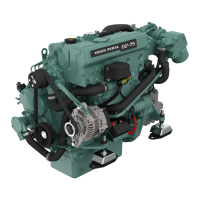Read through the entire instruction before work is begun.
Items in illustrations in this instruction may differ from
the model being worked on. The illustrations are used
for different instructions and may therefore vary between
engine models. The essential information is correct.
How to build an engine bed
Fig.1
Installation dimensions for all engines with reverse gear.
For more detailed information, refer to the installation
drawing for the engine and transmission concerned.
IMPORTANT!
changes, MIN 40 mm.
Fig.2
Jig
1. Build the engine bed to conform with any existing shaft
or shaft gland.
2. Fiberglass the shaft gland to conform with any existing
engine bed.
Refer to installation instruction 47706011 for further info
Fig.3
IMPORTANT!
The RB reverse gear is longer than the MS reverse gear.
Cut the propeller shaft by between 55-60 mm as illus-
trated.
Fig 4
* Existing bed
MD5: lower the existing bed.
MD17C/ MD21 A-B:raise the forward section and lower
the aft section of the bed.
Check bed width!
Fig.5
Recommended engine bed design with side reinforce-
ment (5).
-
-
bent. High density material is generally better at dampen-
ing sound. The engine bed must be torsionally stiff and
able to withstand the loads it is exposed to. Note: The
engine bed is subjected to large forces in heavy seas.
Fig.6
the bed. Refer to Fig. 5.
Build in drainage channels (4) so that bilge water is able
to run to the bilge pump. Use e.g. plastic pipes as drain-
age channels.
1 Filling material
2 Fiber glass
3 Galvanized steel strip MIN 10 mm.
4 Drainage channel
5 Side reinforcement
Fig.7
A Steel strip width: MIN 60 mm.
B Engine bed width: 85 mm
Build in 4 pcs galvanized steel plates that are minimum
10 mm thick, 60 mm wide and 200 mm long. Alternatively,
build in two long strips on each side of the engine bed.
Fig.8
sides, etc. The recommended clearance (C) is min 20 mm.
Lift the engine into place on the brackets and secure the
engine pads with bolts. The engine pad rubber must be
under load for 24 hours before engine attachment to the
the D1/D2 installation manual.
Fig.9-10
out measurements as illustrated.
Maximum engine vibration level (Fig.9)
Maximum engine bed vibration level (Fig.10)
It is important to follow the recommendations above to
avoid vibration problems.
IMPORTANT!
High engine bed vibration levels can also cause high
engine vibrations.
Fig.11
Example of a simple instrument for measuring vibrations
one axis at a time.
For more information, contact the nearest Volvo Penta
dealer.
NOTE!
All kits are made according to Volvo Penta installation
drawings.
It does happen that some boatbuilders make their own
engine bed, engine pads and bracket variants.
For S-drive installation instructions, refer to 47705928.

